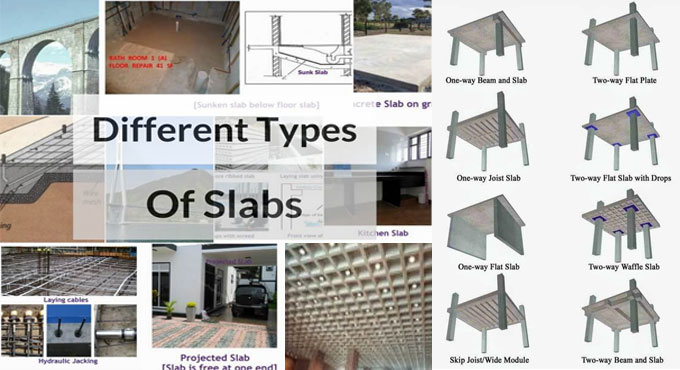
Basics About RCC Slabs in Construction

RCC stands for reinforced cement concrete slabs. It is the most important element in the construction industry to make a building. RCC slab is a structural component. The RCC slabs are supported on the columns and beams. RCC Slabs whose thickness ranges from 10 to 50 centimeters are most often used for the construction of floors and ceilings.
Thickness of RCC
The minimum thickness of RCC slabs is 5 inches. According to the AMERICAN CONCRETE INSTITUTE, the minimum thickness of the RCC slab should be 5 inches. According to Indian Standard, the minimum thickness of the RCC slab is restricted to 4 times the nominal size of aggregate. The minimum thickness should not be less than 4.75 inches.
Types of Slabs
Corrugated Slab - this is the type of slab where the concrete is poured into a corrugated steel tray. This type of RCC slab increases the strength and prevents the slabs from bending under their own weight. It runs across from side to side.
A Ribbed Slab - this type of slab provides extra strength in one direction.
A Waffle Slab - this type of slab gives added strength in both directions.
One-way Slab - this type of slab has structural strength in the shortest direction.
Two-way Slab - it has structural strength in two directions.
Cost of RCC Slab
Cost of RCC Slab for 2000 sq ft, 5? thick and cement concrete 1;2;4. The approximate cost is Rs 3 lac including the material, labor, and MS steel bars.
Requirement of Steel
The required Steel for the RCC slab is 80 kgs/m3, then the quantity of steel required for 100 sq ft ( 1.18 m3) RCC slab is equal to = 80 ? 1.18 = 94.5 Kgs. 94.5 Kgs steel quantities are required for 100 sq ft 5-inch thick RCC roof slab.
Calculation of RCC Slab
1. For slabs = 1.0 % of concrete volume is needed.
2. For Beam = 2 % concrete volume is needed.
3. For column = 2.5 % of concrete volume is needed.
4. For RCC Roads, 0.6% concrete volume is needed.
Type of Steel is used in RCC Slab
Mild steel bars are used in RCC slabs for their tensile strength. These types of steel bars are plain in shape on the surface and are round sections of diameter from 6 to 50 mm.
Usage of RCC Slab in Construction
RCC slab can be cast in two ways. After casting in the factory prefabricated concrete slabs are transported to the site and ready to be lowered into place between steel or concrete beams. Users should take care to see that the supporting structure is built to the correct dimensions and it avoids trouble with the fitting of slabs over the supporting structure.
Situ concrete slabs are built on the building site by using formwork. Formwork is a box-like setup in which concrete is poured for the construction of slabs. For reinforced concrete slabs, reinforcing steel bars are placed within the formwork and after that, the concrete is poured.
Plastic bar chairs are used for holding the reinforcing steel bars away from the bottom and sides of the form-work. It is done that way because when the concrete sets it completely envelops the reinforcement.
The span - effective depth ratio
As a slab is usually a slender member so the restriction on the span-depth ratio becomes more important in construction. this can often control the depth of slab required in terms of the span ? effective depth ratio is given by, Minimum effective depth = span/(basic ratio x modification factor)
Used Material for the Formwork
The formwork is made from wooden planks and boards, plastic, and steel. Though plastic and steel are more common these days. On low budget sites, wooden planks are more common. After setting up the concrete the wood is removed.
Sum Up
In this article, we discussed Thickness, types, cost, the requirement of steel, calculation of RCC, types of steel, Usage of RCC slab, The span - effective depth ratio, and the material for the formwork.
If readers like this article please share your comments with us. You can write down comments in the comment box below the article.


